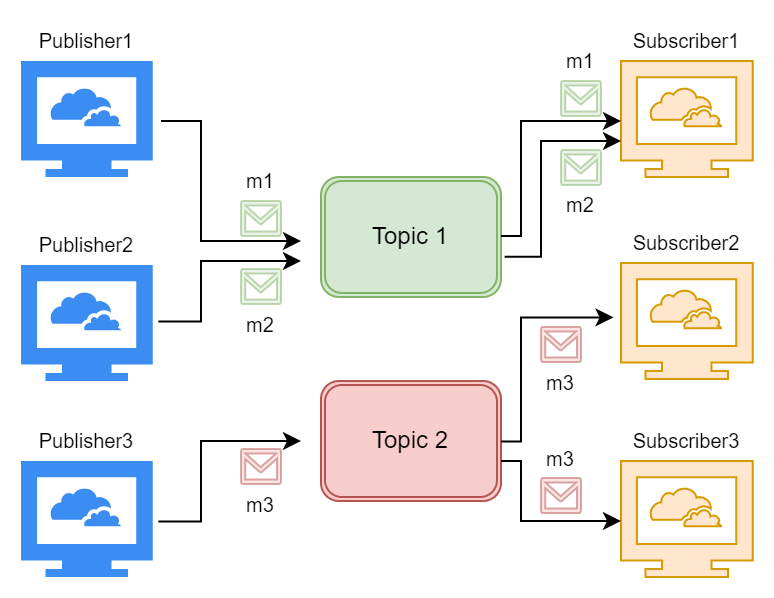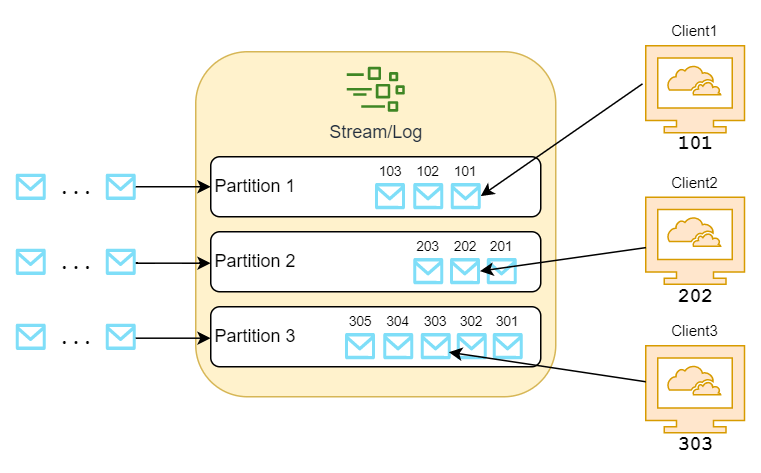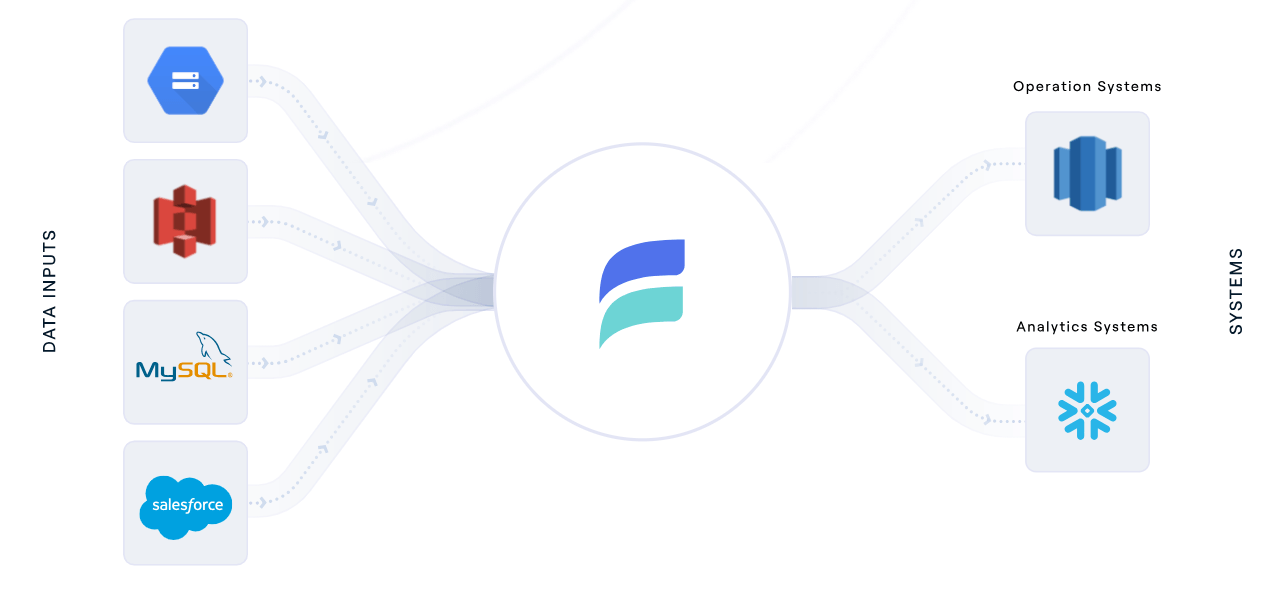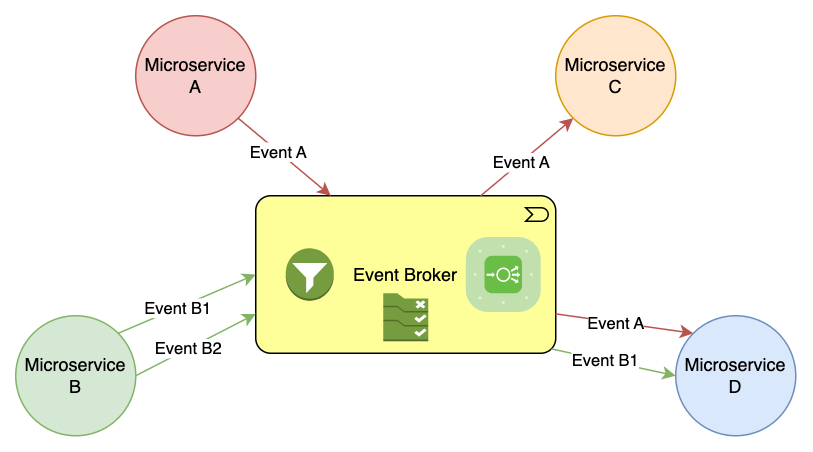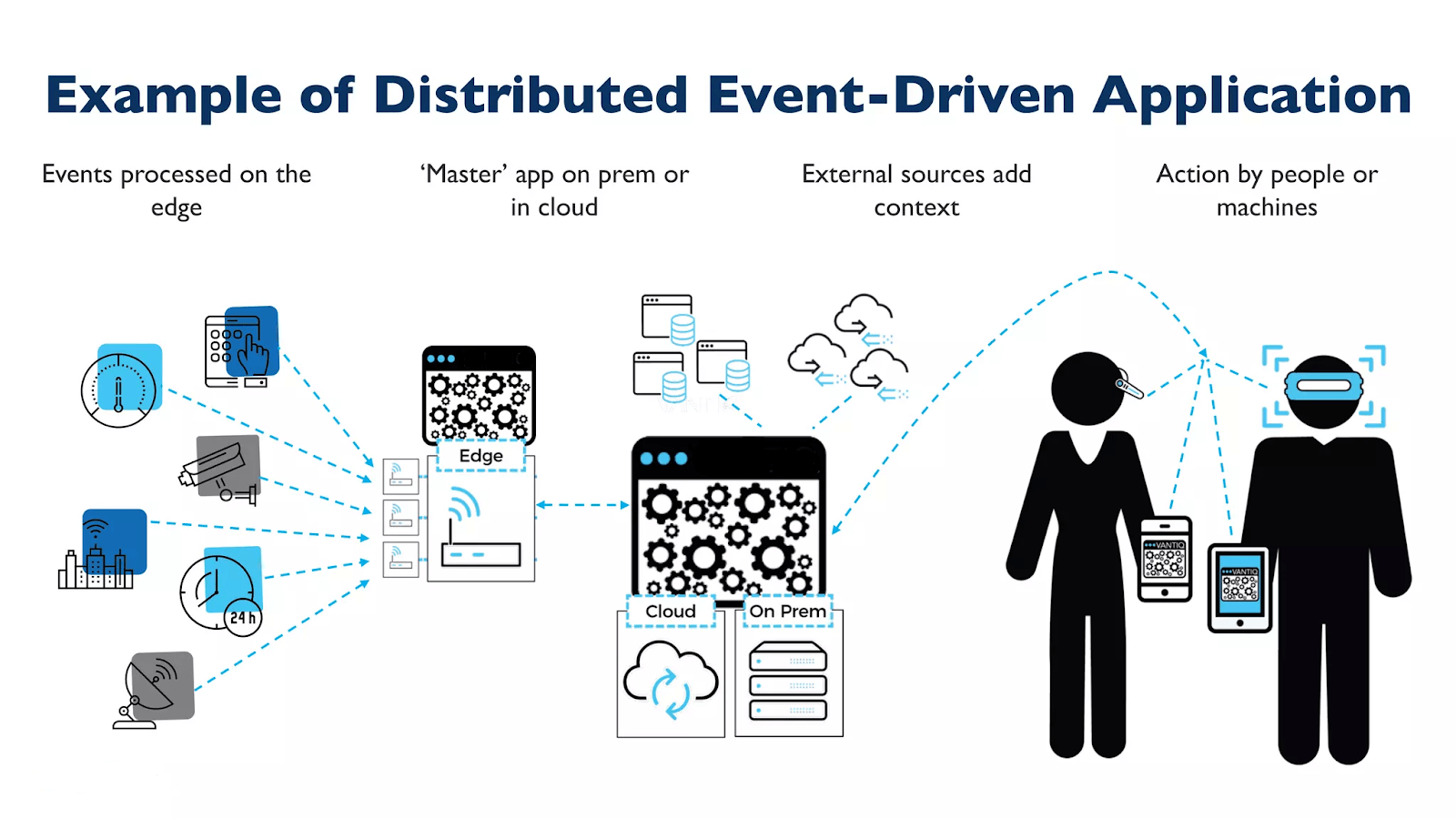
Boldly challenging the status quo, event-driven architecture (EDA) is the champion of modern software systems that has disrupted the traditional ways of communication between applications. Instead of the old-fashioned request-response approach, it introduces a new and powerful concept: events. In a world that demands instant gratification, the asynchronous nature of events culminates in rapid responsiveness to real-time data.
It's no wonder that event-driven architecture is gaining immense popularity in the tech world. 72% of global businesses have already hopped on the EDA bandwagon, and the trend is only getting bigger and better. So, what's the secret behind this surge in popularity?
Well, you're about to find out. Get ready for a deep dive into event-driven architecture – we've got you covered with everything you need to know – from its different models and components to exploring its inner workings and best tools for the job.
What Is Event-Driven Architecture (EDA): Covering The Basics
Event-driven architecture, or EDA, is a system design paradigm where the primary focus is on events - actions or changes that occur within the system. It captures, shares, processes, and stores these events, making it a flexible option for various software designs.
In an event-driven system, the event notification confirms that an event has occurred and carries additional event-specific data. For example, let’s consider an online food delivery platform. A customer placing an order triggers an 'event.' This event carries detailed information like the customer's name, order details, and delivery address. Or it could simply be an identifier like "Order #12345 placed."
Upon triggering the event, it activates various services in real-time – all of this happening simultaneously and immediately. It shows how responsive and efficient EDA can be.
Event-driven architecture mainly centers around generating and handling events. It is also known as message-driven architecture because the system heavily relies on event notifications or messages to make things work smoothly.
EDA has a huge impact on modern applications. It helped promote efficient information exchange among networked devices, microservices, and applications. With this real-time event data flow, the systems stay up-to-date as events happen which adds significant value to IT systems in this digital age.
2 Event-Driven Architecture Models For Business Advancement
Event-driven architecture often falls into 2 broad categories. Let’s discuss them and see how EDA is used in different contexts.
Pub/Sub Model
In the publisher/subscriber or 'Pub/Sub' model, messages originate from an event sourcing system which then broadcasts them to decoupled systems. Rather than addressing messages to a process-specific queue, they are usually shared on a common topic.
This way, any number of consumers can subscribe and get notified of related events. With the Pub/Sub model, you have the freedom to handle your workloads and scale them as required which gives increased flexibility to the entire system.
Event Streaming Model
Event stream processing uses platforms like Gazette to intake events and perform modifications on the event stream. This form helps identify important patterns within the flow of events. It processes data sequentially to enable real-world aggregation, correlation, and filtering, transforming massive amounts of data into meaningful insights.
Patterns In Event Processing: Better Insight & Efficiency
In an event-driven system, events are processed following these common patterns:
- Simple Event Processing (SEP): This pattern triggers immediate action when it receives an event, with minimal extra processing or message filtering.
- Complex Event Processing (CEP): CEP requires multiple events that meet specific criteria to occur before triggering an action.
- Pub/Sub Processing: In this pattern, you must subscribe to certain topics to receive messages.
- Event Stream Processing (ESP): In this pattern, you read from real-time streams and be flexible to start reading from any position.
Understanding The Key Concepts Of Event-Driven Architecture
Event-driven architecture has some important concepts that shape how events are produced, shared, and processed. To implement EDA effectively, let’s understand these concepts well.
Event Producer/Publisher
The event producer is responsible for initiating and generating events. It identifies when an event should be triggered and publishes it to the event bus or broker.
Event Broker
The event broker serves as the mediator in the event-driven architecture environment. This middleware component exists in different forms like software, an appliance, or even SaaS. It takes responsibility for event routing between systems. With the help of an event portal, it ensures effective point-to-point communication between those dispatching and those reacting to events.
Event Consumer/Subscriber
The event consumer receives and processes events from the event bus or broker. It reacts to events and takes appropriate actions based on the event's information.
Event Handler
The event handler is a logical component that processes specific types of events. When an event is received, the corresponding event handler processes the event and executes the necessary actions or logic.
Event Portal
The event portal is the solution to the complexities of documenting design processes in event-driven architecture. It provides a platform for the design, creation, visualization, and management of events. It becomes a central hub for architects, developers, and data scientists to understand and reuse events across different applications.
Topics
Each event in an event-driven architecture system carries a tag, known as a "topic”. This metadata explains the event’s content and helps publishers send events to the right event channels. At the same time, applications can subscribe to topics that are relevant to them. The strategic use of topic hierarchy makes event distribution and consumption more efficient.
Event Mesh
An event mesh is a flexible infrastructure layer that works with interconnected event brokers. It distributes events among different applications, cloud services, and devices, keeping them loosely connected. It shares consumer topic subscription information which helps with message routing and ensures events reach the right places at the right time.
Deferred Execution
Instead of waiting for an immediate response after sending an event, the event broker holds the event until all the interested consumers receive it. This can set off chains of events where actions happen in a sequence that's independent in time but related to each other.
Eventual Consistency
Because of this deferred approach, we can't be sure exactly when a particular database will update or when all stateful entities will reach consistency. But what we know is that they will reach a state of consistency eventually.
The Choreography Concept
In an event-driven architecture environment, services react to incoming events and often produce new events, which causes an implicitly coordinated response. This spontaneous “dance” of services helps in the seamless operation of the EDA system.
CQRS: Command Query Responsibility Segregation
The CQRS pattern is a popular approach in scaling microservices within an EDA. It separates the services that perform actions (commands) and those that answer queries. This separation simplifies scaling, particularly for the query service that often has a higher load. The event-driven architecture includes the command or query action within the topic to further ease this process.
Simplify Event-Driven Operations Using Estuary Flow
Estuary Flow emerges as a versatile solution within the context of event-driven architecture, offering a comprehensive platform designed to enhance your operations. It provides managed services for Change Data Capture (CDC) and Extract, Transform, Load (ETL) pipelines, coupled with streaming SQL transformations. These features are essential for EDA for immediate data processing and analytics.
Flow provides powerful transformations using streaming SQL and Javascript and maintains low-latency views across systems of choice. This feature set aligns well with the principles of EDA and makes Estuary a valuable asset for businesses adopting this approach.
- Real-Time Data Processing: Estuary provides real-time data processing which is a key aspect of EDA. It swiftly transfers data and transforms it for immediate reaction to business events.
- Data Replication & Migration: Estuary supports real-time data replication and migration for consistency across various services and components in EDA.
- Streaming SQL Transformations: Flow offers true streaming SQL and Javascript transformations which enables real-time data manipulation and analysis in EDA.
- Scalability and Resilience: Flow scales with your data and ensures resilience across regions and data centers – crucial for handling large volumes of events and data in EDA.
- Exactly-Once Semantics: Flow guarantees exactly-once semantics for transactional consistency in EDA where the same event should not be processed more than once.
- Schema Inference: Flow offers schema inference to turn unstructured data into structured data. This is beneficial for processing and analyzing events in various formats in EDA.
How Does Event-Driven Architecture Work?
Event-Driven Architecture (EDA) operates on the principle of state changes or crucial actions triggering events. These major occurrences within the system are recognized by the component known as event producers. They put the identified event into a message without any knowledge of the event's consumer or eventual consequence.
These events then make their way through the system via an event bus. The event bus routes these events to the components that have subscribed to them to effectively convey the changes in the state throughout the system.
Event consumers are components within the system that act when they receive an event. They process the event or are influenced by it. The event processing is performed asynchronously on a platform designed for this purpose, like middleware event managers. These platforms support real-time publishing, subscription, storage, and processing of event streams.
6 Proven Benefits Of Using Event-Driven Architecture
Event-driven architecture provides several benefits that make it a powerful approach to designing modern applications. Let’s discover all these perks that EDA has in store for us.
The Advantage Of Decoupling
One of EDA's main strengths lies in its decoupling capabilities. Services can collaborate seamlessly without any direct knowledge of each other. The focus shifts from service-to-service interaction to events management through a broker to efficiently route the events to the right systems.
Immutability: A Security Boost
In an event-driven system, events, once formed, remain unchanged. This way, multiple services can freely share information without the risk of any one service changing or deleting it.
Persistability: No Single Point Of Failure
Event-driven architecture provides a robust response to service downtime. When a service is offline, the broker retains the event until the service resumes. This mitigates the risk of failed requests and errors and increases the system's resilience and continuity.
Scalability At Its Best
Due to EDA's scalability, a single event can trigger multiple actions across various consumers. This parallel task execution speeds up the overall performance.
Real-Time Responses
As events unfold, the system springs into action instantly to provide near-instantaneous responses. This real-time processing enhances the customer experience, especially in mission-critical interactions like purchases or customer support chats.
Simplified Audit Process
Event-driven architecture provides a clear path for auditing and compliance. Data access control can be centrally managed from the event router. When combined with the unchangeable nature of events, this builds a reliable and thorough audit trail to streamline the compliance process.
To see how top companies are leveraging these benefits of event-driven architecture in real-world scenarios, check out these 10 Event-Driven Architecture Examples
Navigating The Challenges Of Event-Driven Architecture
Even though event-driven architecture has some great advantages, it's not all smooth sailing. Hurdles like latency and eventual consistency can hold you back. Let’s discuss these challenges in detail to see how you can stay clear of them.
In contrast to monolithic applications, event-driven systems operate across networks, introducing variable latency. This feature can sometimes lead to slower processing times. Furthermore, the flow of many events through multiple services in an architecture can introduce a state of eventual consistency, adding complexity to transaction processing and state determination.
Potential Performance Setbacks
In event-driven architecture, the presence of a broker or 'middle man' between event producer and consumer services can occasionally slow performance. Events might not reach consumers as quickly as they would via a direct service-to-service channel.
Eventual Inconsistency
An event signifies a change in state and with numerous events passing through various services, systems usually reach a state of eventual consistency. Although all services will finish processing the event, the different processing times cause inconsistencies in the interim.
Complex Monitoring And Debugging
EDA reduces dependency tracking which is a common barrier in a microservices architecture. However, this independence makes it difficult to monitor the status of events across multiple applications. Debugging in these systems can be complex because of the separate log files for each service and function.
Asynchronous Communication
Event-driven applications often operate asynchronously and the services do not wait for responses before proceeding with other tasks. While this characteristic increases scalability and flexibility, it complicates the return of values or workflow results.
Workflow Orchestration Challenge
Over time, simple workflows evolve into more complex ones. This complexity calls for an orchestrator to keep track of the system state, manage branching logic, handle different failure models, and oversee retry logic.
Event-Driven Architecture Use Cases: Exploring The Versatility
Event-driven architecture is a popular choice for many businesses because it offers real-time data and works well in different situations. This approach opens up a wide range of possibilities and benefits in various domains. Let's take a closer look at some of these exciting use cases.
- Parallel processing: With event-driven architecture, a single event can trigger multiple processes to run independently. Synchronous processing helps execute tasks efficiently without any bottlenecks.
- Real-Time Monitoring: EDA provides a robust framework for real-time monitoring. System changes generate events and let organizations detect anomalies and suspicious activities swiftly.
- Data analytics in IoT Networking: In IoT device networking, EDA is used for efficient data analytics. The continuous flow of real-time data helps in effective monitoring and decision-making.
- Achieving interoperability: Events in EDA can be persisted and propagated regardless of the coding language of the services. This promotes interoperability among different system components.
- Replication of data: Event-driven architecture permits the replication of data across multiple services. Whenever events occur, their data can be copied into different service databases which promotes data consistency.
- Streamlining application integration: Application integration is made more efficient through event-driven architecture. Real-time event processing lets different applications work together seamlessly to create a cohesive system.
- Data sharing between applications: EDA lets different applications seamlessly share data. The real-time nature of data delivery ensures that updated information is readily available across various system components.
- Enhancing microservices with events: Microservices can be event-enabled which promotes efficient communication and data sharing. This improves the overall functionality of the system and lets each component operate optimally.
Understanding the processing logic of events is just one element of mastering event-driven architecture. It's equally important to familiarize yourself with the most commonly used EDA tools so you pick the one that best suits your needs.
6 Most Widely Used Event-Driven Architecture Tools
Here are the 6 best EDA tools that provide different functionalities ranging from data processing and streaming to message queuing and storage services.
Kafka
Apache's Kafka is a renowned event streaming software. This open-source pub-sub management platform stands as a distributed system for streams and can collect, process, store, and analyze data. Like most stream processors, it’s built to withstand high-traffic enterprise-level operations, allowing it to handle thousands of messages per second.
Amazon Kinesis
Amazon Kinesis, part of the Amazon AWS suite, is another notable name in data streaming. It integrates seamlessly with other AWS offerings like Lambda, Amazon AI Services, and Amazon Redshift. Kinesis is known for enabling continuous data analysis, irrespective of the source.
Confluent Platform
The Confluent Platform is a service distribution of Kafka, offering both cloud-based and enterprise-grade software versions. The self-managed Confluent Platform enhances Kafka's core pub-sub management capabilities with additional processing and data storage functions.
RabbitMQ
RabbitMQ, owned by VMWare, is a versatile message broker that supports several protocols, including MQTT, AMQP, and STOMP. It uses asynchronous messaging and can be deployed either on-premises or via the cloud.
Pulsar
Apache's Pulsar is a messaging and streaming event-based platform. It operates as a tier of stateless broker instances. It connects with a separate tier of BookKeeper instances for message writing/reading and optional storage and replication.
Gazette
Gazette offers a unique approach by using a "journal" concept, acting as both a low-latency data stream and a collection of organized files in cloud storage. This enables real-time filtering, forwarding, aggregation, and indexing, while also supporting querying through SQL using various tools like Snowflake and BigQuery. Gazette's consumer framework empowers the creation of streaming applications in Go, making it a versatile solution for managing event-driven data processing tasks.
Conclusion
The reliability and resilience of event-driven architecture become more important in the face of relentless cybersecurity threats. The decentralized nature of EDA ensures that a single failure doesn't cripple the entire system. It's a dynamic, responsive framework that lets you react to real-time information for efficiency and innovation.
Estuary Flow is a powerful tool that can help you to benefit from event-driven architecture. It uses CDC to ensure that the data is always up-to-date and avoids outdated or duplicated information. With its powerful tools, you can tailor the data as it flows into the system. Flow incorporates built-in testing features to ensure error-free and reliable data pipelines. It creates low-latency views of your data so that information remains consistent across different systems.
Interested in learning more? Sign up for Estuary today and discover a new level of performance and innovation. If you have any questions or need further information, don't hesitate to contact us.

Author
Popular Articles







